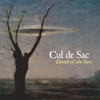Cul De Sac, "Death of the Sun"
Strange Attractors
 Tradition and innovation are powerful forces, always tugging, tearingat each other, one struggling to hold on, and the other struggling tobreak free. This is a tension observable right now in our culture, asthe means of producing electronic music becomes available to mostanyone with a personal computer and an idea, these new concepts of whatconstitutes artistic expression often clash with established notions ofwhat makes something real or true. These are cultural growing pains, asensation of vertigo that comes with progress and the flexing ofboundaries. On Death of the Sun,Cul de Sac takes both tradition and innovation and uses themingeniously to create harmony from tension. The members of Cul de Sacbegan by assembling a myriad of sources and samples from antique vinylrecords to ambient forest and city soundscapes. These sources were thenelectronically manipulated and modified to serve as a musical spine forthe piece. Throughout the album, fuzzy, distant voices drift inmomentarily amidst clicks and static. The electronic foundation issolid, and its intricacy makes this an amazing headphone listen. Addingeven more layers of complexity, the members of Cul de Sac respond tothis electronic foundation, counter-pointing the synthetic and thetreated with acoustic instruments like violins, guitars, melodicas, anddrums. Their response was not to canned, prepared pieces, but toelectronic sequences that were played live and on the spot duringrecording. On "Dust of Butterflies," a lone acoustic guitar unfolds amusic box melody that itself is sampled and looped over theelectronically modified snapshot of a five-part harmony found on arecord from 1933. "Turok, Son of Stone" consists of a building chorusof primeval percussion that is visceral in its attraction. Thepercussive theme continues through the dark, insistent "Death of theSun," churning dirt and dust before fading away with an aching violin.The final piece, "I Remember Nothing More" samples a minute of an old78-RPM record of Creole songs released in 1940. The singer, AdelaideVan Wey's voice peeks through the tender acoustic guitar, the vinylscratches and fuzz casting her like a faraway, fading transmission. Theeffect is eerie, listening to her soulfulness repurposed in thismanner. The clash between traditional and innovative comes togetherhere, and for a moment, Cul de Sac has made them one concept, oneexpression of clarity. Death of the Sun is a fascinating album,fusing so many seemingly dissonant threads and melding innovative ideasand techniques with traditional sounds and sensibilities.
Tradition and innovation are powerful forces, always tugging, tearingat each other, one struggling to hold on, and the other struggling tobreak free. This is a tension observable right now in our culture, asthe means of producing electronic music becomes available to mostanyone with a personal computer and an idea, these new concepts of whatconstitutes artistic expression often clash with established notions ofwhat makes something real or true. These are cultural growing pains, asensation of vertigo that comes with progress and the flexing ofboundaries. On Death of the Sun,Cul de Sac takes both tradition and innovation and uses themingeniously to create harmony from tension. The members of Cul de Sacbegan by assembling a myriad of sources and samples from antique vinylrecords to ambient forest and city soundscapes. These sources were thenelectronically manipulated and modified to serve as a musical spine forthe piece. Throughout the album, fuzzy, distant voices drift inmomentarily amidst clicks and static. The electronic foundation issolid, and its intricacy makes this an amazing headphone listen. Addingeven more layers of complexity, the members of Cul de Sac respond tothis electronic foundation, counter-pointing the synthetic and thetreated with acoustic instruments like violins, guitars, melodicas, anddrums. Their response was not to canned, prepared pieces, but toelectronic sequences that were played live and on the spot duringrecording. On "Dust of Butterflies," a lone acoustic guitar unfolds amusic box melody that itself is sampled and looped over theelectronically modified snapshot of a five-part harmony found on arecord from 1933. "Turok, Son of Stone" consists of a building chorusof primeval percussion that is visceral in its attraction. Thepercussive theme continues through the dark, insistent "Death of theSun," churning dirt and dust before fading away with an aching violin.The final piece, "I Remember Nothing More" samples a minute of an old78-RPM record of Creole songs released in 1940. The singer, AdelaideVan Wey's voice peeks through the tender acoustic guitar, the vinylscratches and fuzz casting her like a faraway, fading transmission. Theeffect is eerie, listening to her soulfulness repurposed in thismanner. The clash between traditional and innovative comes togetherhere, and for a moment, Cul de Sac has made them one concept, oneexpression of clarity. Death of the Sun is a fascinating album,fusing so many seemingly dissonant threads and melding innovative ideasand techniques with traditional sounds and sensibilities.
 Tradition and innovation are powerful forces, always tugging, tearingat each other, one struggling to hold on, and the other struggling tobreak free. This is a tension observable right now in our culture, asthe means of producing electronic music becomes available to mostanyone with a personal computer and an idea, these new concepts of whatconstitutes artistic expression often clash with established notions ofwhat makes something real or true. These are cultural growing pains, asensation of vertigo that comes with progress and the flexing ofboundaries. On Death of the Sun,Cul de Sac takes both tradition and innovation and uses themingeniously to create harmony from tension. The members of Cul de Sacbegan by assembling a myriad of sources and samples from antique vinylrecords to ambient forest and city soundscapes. These sources were thenelectronically manipulated and modified to serve as a musical spine forthe piece. Throughout the album, fuzzy, distant voices drift inmomentarily amidst clicks and static. The electronic foundation issolid, and its intricacy makes this an amazing headphone listen. Addingeven more layers of complexity, the members of Cul de Sac respond tothis electronic foundation, counter-pointing the synthetic and thetreated with acoustic instruments like violins, guitars, melodicas, anddrums. Their response was not to canned, prepared pieces, but toelectronic sequences that were played live and on the spot duringrecording. On "Dust of Butterflies," a lone acoustic guitar unfolds amusic box melody that itself is sampled and looped over theelectronically modified snapshot of a five-part harmony found on arecord from 1933. "Turok, Son of Stone" consists of a building chorusof primeval percussion that is visceral in its attraction. Thepercussive theme continues through the dark, insistent "Death of theSun," churning dirt and dust before fading away with an aching violin.The final piece, "I Remember Nothing More" samples a minute of an old78-RPM record of Creole songs released in 1940. The singer, AdelaideVan Wey's voice peeks through the tender acoustic guitar, the vinylscratches and fuzz casting her like a faraway, fading transmission. Theeffect is eerie, listening to her soulfulness repurposed in thismanner. The clash between traditional and innovative comes togetherhere, and for a moment, Cul de Sac has made them one concept, oneexpression of clarity. Death of the Sun is a fascinating album,fusing so many seemingly dissonant threads and melding innovative ideasand techniques with traditional sounds and sensibilities.
Tradition and innovation are powerful forces, always tugging, tearingat each other, one struggling to hold on, and the other struggling tobreak free. This is a tension observable right now in our culture, asthe means of producing electronic music becomes available to mostanyone with a personal computer and an idea, these new concepts of whatconstitutes artistic expression often clash with established notions ofwhat makes something real or true. These are cultural growing pains, asensation of vertigo that comes with progress and the flexing ofboundaries. On Death of the Sun,Cul de Sac takes both tradition and innovation and uses themingeniously to create harmony from tension. The members of Cul de Sacbegan by assembling a myriad of sources and samples from antique vinylrecords to ambient forest and city soundscapes. These sources were thenelectronically manipulated and modified to serve as a musical spine forthe piece. Throughout the album, fuzzy, distant voices drift inmomentarily amidst clicks and static. The electronic foundation issolid, and its intricacy makes this an amazing headphone listen. Addingeven more layers of complexity, the members of Cul de Sac respond tothis electronic foundation, counter-pointing the synthetic and thetreated with acoustic instruments like violins, guitars, melodicas, anddrums. Their response was not to canned, prepared pieces, but toelectronic sequences that were played live and on the spot duringrecording. On "Dust of Butterflies," a lone acoustic guitar unfolds amusic box melody that itself is sampled and looped over theelectronically modified snapshot of a five-part harmony found on arecord from 1933. "Turok, Son of Stone" consists of a building chorusof primeval percussion that is visceral in its attraction. Thepercussive theme continues through the dark, insistent "Death of theSun," churning dirt and dust before fading away with an aching violin.The final piece, "I Remember Nothing More" samples a minute of an old78-RPM record of Creole songs released in 1940. The singer, AdelaideVan Wey's voice peeks through the tender acoustic guitar, the vinylscratches and fuzz casting her like a faraway, fading transmission. Theeffect is eerie, listening to her soulfulness repurposed in thismanner. The clash between traditional and innovative comes togetherhere, and for a moment, Cul de Sac has made them one concept, oneexpression of clarity. Death of the Sun is a fascinating album,fusing so many seemingly dissonant threads and melding innovative ideasand techniques with traditional sounds and sensibilities.



